Out Comes the Science Equipment
Last night, Captain Yousri Maghrabi steered the Palmer toward Station A, at 76.5 degrees south, 170 degrees east. It’s just a patch of open water about 40 miles northeast of Ross Island, but oceanographers have been measuring water here since the mid-1990s. When we got there, the only land left visible were Ross and Beaufort Islands far off our port stern. The occasional Adélie penguin swam by on its way to a small iceberg. Everything else was ocean.
Everyone got a practice run with their instruments before heading to our first major sampling site tomorrow. We dropped instruments 740 meters (almost half a mile) to the seafloor; put pumps overboard to collect particles suspended in the water; and brought water back on board so we could learn about the microorganisms living there. At 2 a.m., a small team set out in an inflatable rubber boat to recover one of our gliders. Read on through the slideshow to find out what happened:
- This is our floating home, the Nathaniel B. Palmer. We spent most of the day at Station A surrounded by open water. Back in December the situation was different. Station A was covered in ice, and glider RU26 couldn’t visit here. Now, at the peak of summer, there’s no ice in sight.
- Yesterday we introduced you to the CTD rosette. Today it was the first instrument over the side, as it is on most oceanographic voyages. The CTD stands for conductivity (which measures salinity, or saltiness), temperature, and depth. Sensors read back these variables as the instrument descends through the water, giving the scientists a detailed picture of basic water conditions. It’s called a rosette because the 24 gray Niskin bottles around the outside make it look like a flower. These bottles are spring-loaded, and an operator onboard can close them at specific depths to collect water samples for analysis.
- The Palmer is a big ship with roomy laboratories, a cold lab, office space, and a control room. Monitors read out all kinds of important data, including the ship’s location and speed, the depth of instruments in the water, and real-time results from the CTD. Scientists gather here to see the data and plan the last details of their sampling. A clock on the wall reads out Greenwich Mean Time, which is 5 hours ahead of New Jersey and 13 hours behind us. Research ships often use this as an unchanging, standard time instead of changing their watches again and again as they cross time zones.
- After the first CTD came back on board, Dr. Chris Measures of the University of Hawaii launched his ‘clean CTD.’ Dr. Measures studies trace metals such as iron, aluminum, and manganese. These occur in such tiny quantities that he must be extremely careful not to contaminate his samples with dust or flakes of metal from tools or the ship itself. As he puts it, the Palmer weighs about 3,400 tons, and most of that is iron. When he measures iron in the water just a few feet away from the ship, he’s looking for a few billionths of a gram, so he’s always on guard against contamination.
- Max Grand, a graduate student with Dr. Measures, carries a 12-liter bottle of sampled water over to the sampling room. To fight contamination, the clean CTD is built on a plastic-coated frame and lowered on a kevlar, not metal, cable; the sampling bottles use rubber instead of metal springs to close up; and the bottle openings are covered with plastic or gloves whenever they are on deck. Max is carrying the bottle into a special ‘clean room’ with filtered air to keep out dust. While they conduct their analyses, the door to the room is kept locked so no one can get in and bring ‘dirty air’ with them.
- While Dr. Measures’s team looks for trace metals dissolved in the water, Dr. Phoebe Lam, of the Woods Hole Oceanographic Institution, and her student Dan Ohnemus want to study tiny particles of trace metals suspended in the water. To collect enough of these, they lower battery-powered pumps over the side. The pumps run for an hour at a time, circulating 1,000 liters (about 250 gallons) of water through filters to collect just a few millionths of a gram of the particles. They have their own clean room—it’s called a ‘bubble,’ and we’ll explore it in a future post.
- The biologists on our science team spent the day sampling, too. Dr. Bob Sanders of Temple University and Dr. Rebecca Gast and graduate student Elizabeth Halliday of Woods Hole Oceanographic Institution are studying unusual creatures that live a double life: they can make food from sunlight, like plants, but they also eat other creatures, like animals do. To study this unusual ability more closely, the scientists will offer the tiny creatures a special meal—tiny food items that carry a fluorescent label. Later, the team will be able to tell how much eating these unusual plants have been doing by shining a fluorescent light on their sample.
- At 2 a.m., Palmer marine technicians Jullie Jackson and Alan Shaw set out with Dr. Walker Smith of the Virginia Institute of Marine Sciences to recover his glider, ‘Ice Dragon.’ He had launched the glider on the day after Thanksgiving. Just before he picked it up, he sent it on a final dive accompanied by the ship’s CTD, so that he could use the data to calibrate his glider’s instruments.
- With Dr. Smith’s glider on board, the Palmer began steaming toward our next sampling point. This sampling point was chosen based on data that glider RU26 sent when it passed this point two weeks ago. During its dive, RU26 found signs of the water we’ve been looking for—Modified Circumpolar Deep Water. Dr. Kohut’s group thinks this water may be bringing nutrients and trace metals that help plankton grow in the surface water of the Ross Sea. To find out, Kohut said, ‘we’ll be throwing all our instruments over the side tomorrow’ —including this shallow-water glider, RU07.


 January 20, 2011
January 20, 2011 
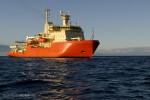
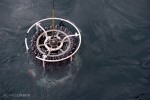
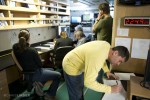
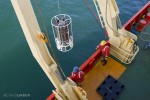
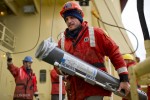
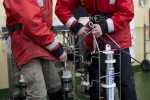
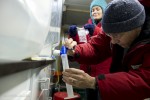
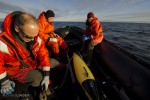
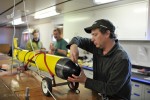







7 Responses to “Out Comes the Science Equipment”